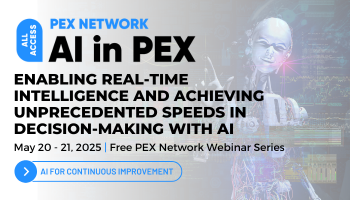Businesses eye AI & automation to solve data divide & resource constraints
Businesses are increasingly turning to artificial intelligence and automation to tackle their biggest challenges
Add bookmarkListen to this content
Audio conversion provided by OpenAI

Businesses have a growing appetite for using artificial intelligence (AI) and automation to solve “data divide” and resource constraints. That’s according to The 2025 Automation Benchmark Report from business transformation company Jitterbit.
The survey, which gathered insights from 1,000 IT decision-makers in the US and UK, found that 97 percent of organizations are prepared to empower line-of-business teams to tackle automation and app development themselves, with AI considered a key piece of the puzzle.
Don't miss any news, updates or insider tips from PEX Network by getting them delivered to your inbox. Sign up to our newsletter and join our community of experts.
An increasing data divide
The data divide – the gap between those who have access to (and feel they have agency and control over) data-driven technologies – is a major challenge facing organizations, the report found. Today, 67 percent of organizations actively manage more than 500 applications, resulting in a staggering 125,000 potential integrations that require continuous oversight, updates and maintenance.
IT teams are struggling to keep up with the growing demand for new applications, automations and integrations due to their limited bandwidth – widening the data divide within organizations. To close the data gap and drive greater collaboration to alleviate IT bottlenecks and offload growing demands on IT teams, organizations are accelerating their integration and automation efforts through low-code and AI-infused technology to unlock business innovation and growth, according to the report.
“IT leaders recognize the need to empower non-technical users to build, deploy and maintain applications and their integrations end-to-end. This reduces IT bottlenecks, improves business agility, lowers costs and drives user-led innovation and collaboration,” the report read.
AI and automation to the rescue?
Almost all (99 percent) surveyed businesses have integrated AI into their operations to drive efficiency across business functions, the report found. Just under a third (31 percent) of enterprises are already planning for agentic AI, signalling the next wave of autonomous decision-making enterprise AI solutions, which require end-to-end AI automation.
Almost three-quarters (72 percent) of respondents estimate that AI automation could save over 160 developer hours every month, with 42 percent citing a reduction in operational costs and 41 percent citing time saved on manual workflows. The areas that benefit most from process automation are operational efficiency (46 percent), customer experience (40 percent), financial forecasting (34 percent) and supply chain management (33 percent), the report found.
“The path to success is clear: businesses must break down data silos and automate workflows to thrive in the age of AI,” said Bill Conner, president and CEO of Jitterbit. While many organizations still struggle to find the resources across IT and line-of-business teams to bridge the data divide, the opportunity for those who can is immense, he added. “We’re on the cusp of a new era of efficiency and innovation, driven by true end-to-end AI automation.”
Legacy automation, designed to execute isolated tasks, is no longer sufficient enough to keep up with modern business demands, according to Manoj Chaudhary, chief technology officer (CTO) at Jitterbit. “Agentic AI is driving a fundamental shift – moving from task-based automation to intelligent automation with adaptive workflows that drive real business outcomes. By leveraging AI-driven decision-making, enterprises can break free from data silos and IT bottlenecks, enabling seamless end-to-end automation.”
AI and automation challenges persist
Despite the promise AI and automation offer, businesses still face stark challenges in adoption. Cyber security, data privacy, scaling, resources and compliance remain the top concerns for IT leaders navigating the AI-powered automation landscape, according to the report.
Half of IT leaders cited vulnerabilities in AI-powered, third-party integrations as their top data security concern. This underscores the urgent need for robust AI security protocols, platform security controls and accountability processes.
All Access: AI in PEX is 2025

All Access: AI in PEX 2025 is designed to address these challenges and empower organizations to successfully integrate AI into their process improvement initiatives. The content series will bring together industry experts, thought leaders, and practitioners to share insights, best practices, and real-world case studies.
Register Now


















